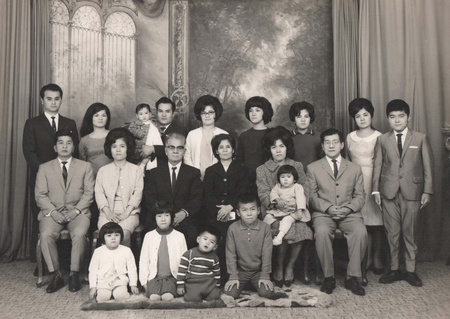I lived a peaceful life with my grandparents on the 11th block of Arnaldo Márquez street in the Jesús María District of Lima (where “anyone who didn’t have Inca blood, had African blood”1), when my parents decided to send me to school. Going to Jishuryo (Santa Beatriz School) and realizing quickly that I was surrounded by “chinos”2 was such a shock that it took me a while to recover (until that time all of my friends had been Peruvian, despite my obā’s warnings not to be friends with “dojin”3).
At recess one day soon after starting school, I don’t remember what we were talking about, but at some point I said “jōri” (referring to the sandals that we called “sayonaras” in Peru) and the boy I was talking to stared at me.
“Did you hear that?” he said to another classmate, pointing at me. “He said jōri!”
“Jōri?” the other boy said with surprise.
And the two of them burst out laughing. I didn’t understand what was so funny. The first boy, looking at me with serious disapproval, told me:
“We don’t say jōri! We say zōri!”
I had grown up with my maternal grandparents and I was sure that at their house we always said “jōri.” I felt something similar to the people who had “recently come down”4 from the mountains to Lima and were teased because they talked “funny.”
Even though I was living with my parents, I spent every weekend at my grandparents’ house; that Saturday I asked my obā about it. Before responding, she asked me what the boys’ names were. I told her and she exclaimed:
“Oh, they’re naichā!”
I didn’t understand, so she explained:
“We are uchinānchu5 from Okinawa and they are naichā, from Tokyo. That’s why they speak better (that’s how she said it: not that they spoke another language but that they spoke “better”).
That’s how I found out that I was uchinānchu.
From then on, whenever I proudly showed her my progress at nihongo, she would tell me which of my classmates were from the countryside and which ones were naichā, based on their last names. If my grandmother had anything against the naichā, I wasn’t aware of it. She never encouraged me to hate or resent them, but seemed to accept with a kind of sad resignation that I was becoming “naichified.”
In school there were people from all over Japan. Although I believe the majority of us were from Okinawa, we didn’t talk about those things. After studying for more than 10 years together, we became a fairly tight group and formed long-lasting and beautiful friendships, and we didn’t care where our parents or grandparents came from.
That’s why for many years it didn’t matter to me that I was uchinānchu. Not even in 1989 when I went to Japan “thanks to Alan García.”6 Was this the land of my ancestors? It didn’t feel like it. I didn’t like the courteous yet cold manner of the Japanese or the mechanical behavior of workers in the factories. Nor was I impressed with their modern infrastructure and I didn’t like their cold weather or their food.
It was only years later, when I went to Okinawa and felt its warmth and saw its white sand beaches, turquoise waters, and light blue sky, only when I recognized the same faces of the obasanes and ojisanes of Peru and their carefree, relaxed way of being, only when I saw their houses with the paint peeling off due to humidity just like in Callao, only when the soki soba, the gōyā champurū, and the sātāandāgī reminded me of the food my obā made, only when the music and dances reminded me of the joyfulness of the ojī and their friends when they got drunk and danced and whistled, only then did I feel that I had “come home.”
I also realized that only the shīsā have faces that are more typically Okinawan than me. I don’t know how Peruvian and how Okinawan I am, but I do know that I am not Japanese at all (and that is fine).
Sometimes I wonder what my life would have been like if I had been born in Okinawa instead of Peru. Would I also be in Kumejima growing sugar cane like my aunts and uncles and cousins, or would I have become naichi from dekasegi and work as a denkiyaen Tsurumi, getting drunk on Saturday nights in one of the bars in Little Okinawa?
Notes:
1. A saying popular in Lima that refers to having indigenous and African ancestry.
2. This is a reference to people of Asian origin in the local vocabulary.
3. Native Peruvians.
4. A migrant from the mountains of Peru to the coastal region.
5. A person from Okinawa.
6. This is a reference to the economic crisis of the first government of President Alan Garcia.
© 2016 Javier Takara





